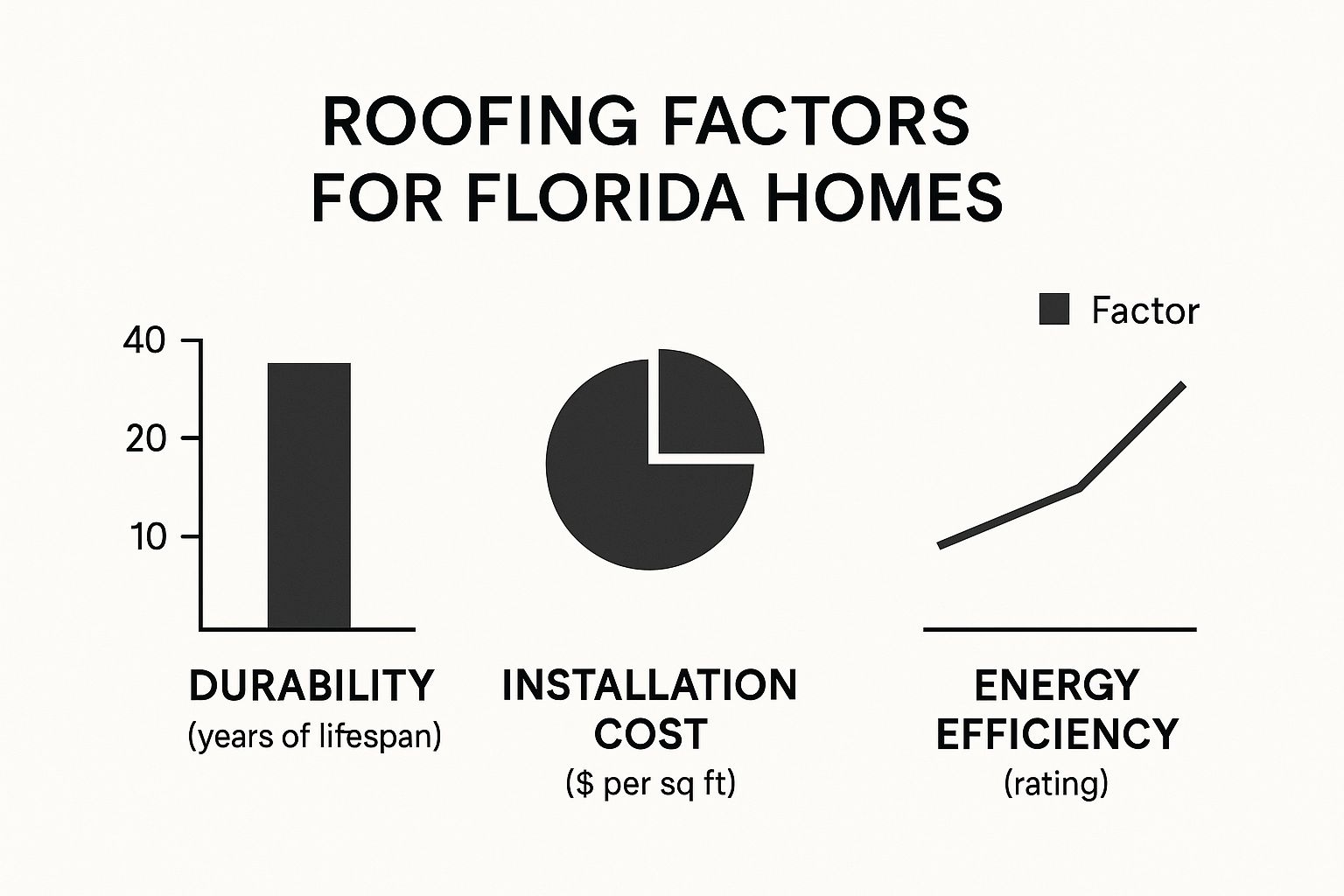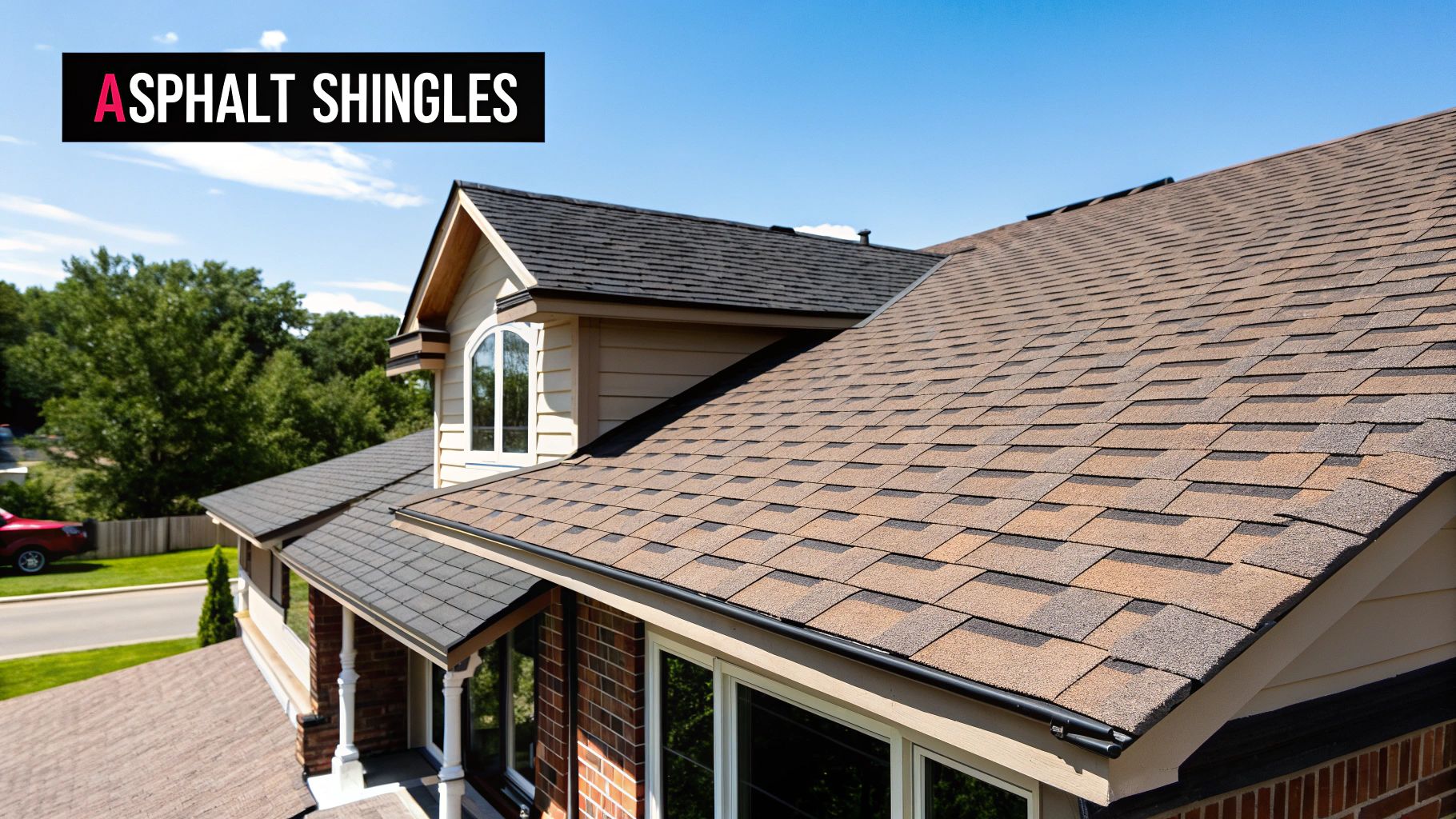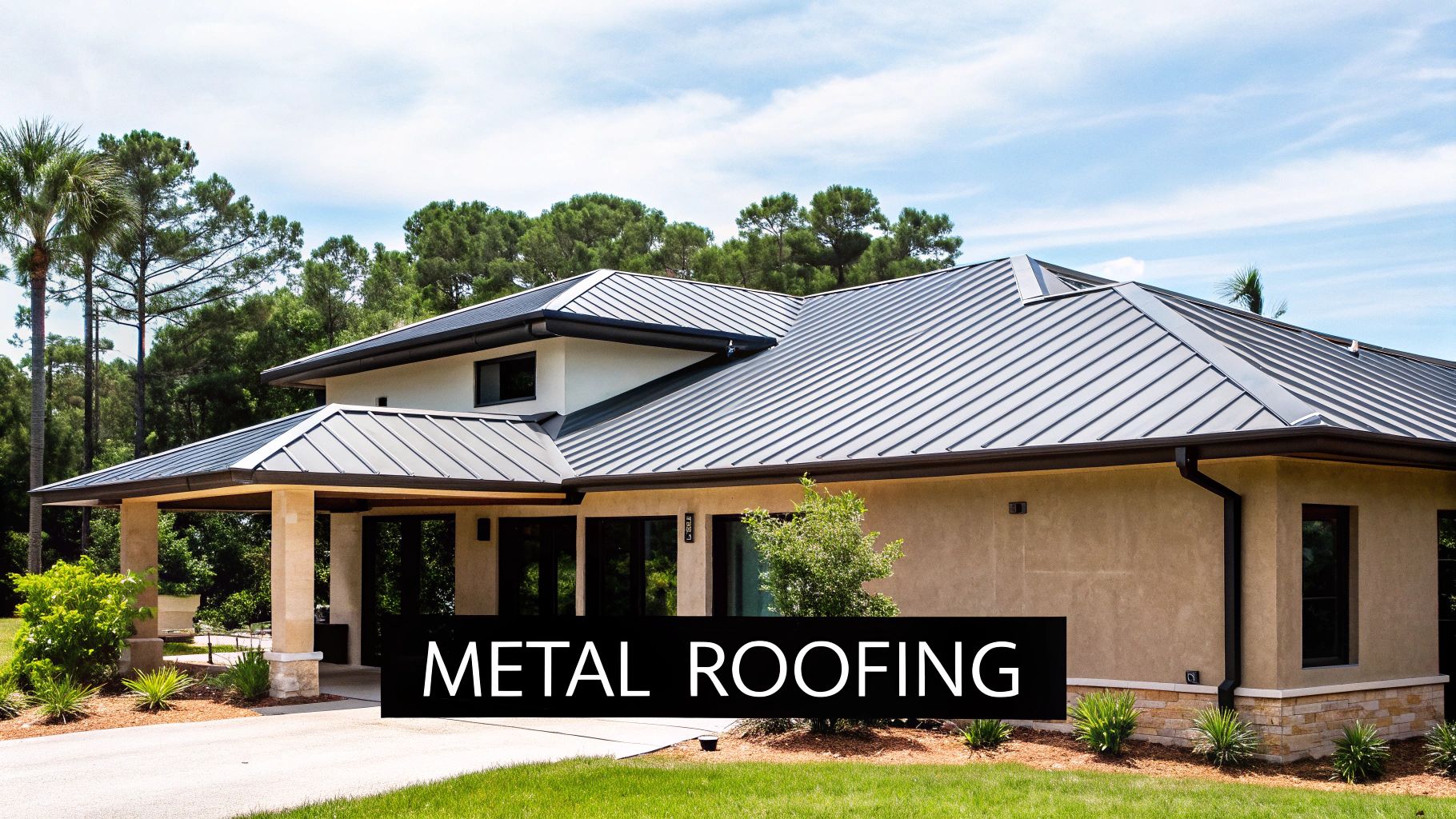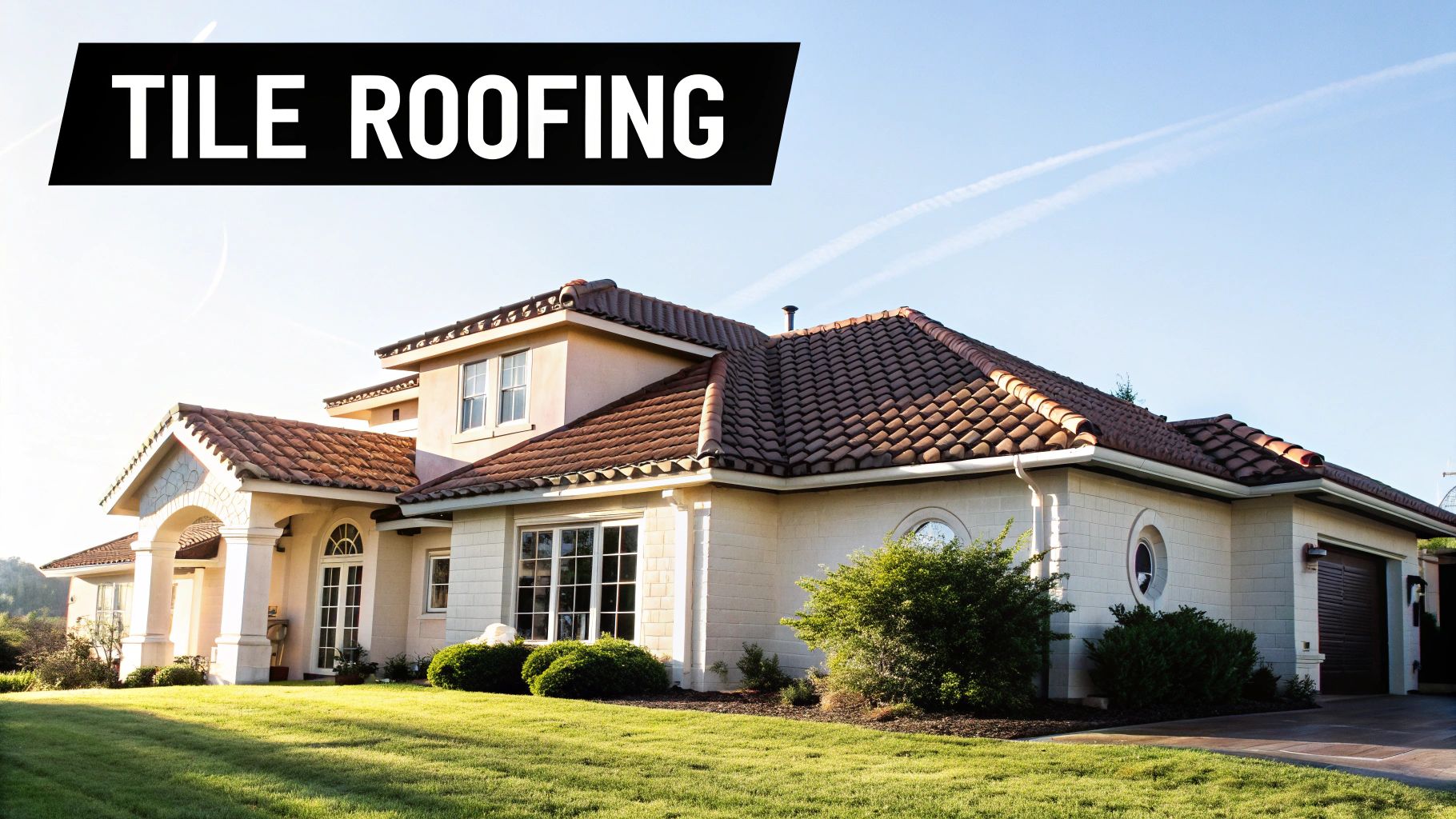When you live in Florida, choosing a roof isn't just a style choice—it's about preparing your home for a relentless barrage of sun, rain, and hurricane-force winds. The best roofing material for Florida homes comes down to balancing your budget, aesthetic preferences, and, most importantly, your need for serious protection.
If your primary goal is maximum storm defense and fantastic long-term value, your best bet is metal. For those who prioritize a classic, time-tested look with proven durability, tile is an outstanding performer.
Choosing A Roof For Florida's Extreme Weather
Picking the right roof in Florida is a direct investment in your home's safety and ability to withstand our unique climate. The combination of intense UV rays, constant high humidity, and the ever-present threat of hurricanes asks a lot more from a roofing system than in most other places. Your decision here will affect everything from your home's safety to your monthly energy bills and curb appeal for decades.
This isn't just a list of pros and cons. This guide provides actionable advice to help you compare the top materials—metal, tile, and architectural asphalt shingles—for your Florida home.
Key Factors For Florida Roofing
To make an informed choice, you must evaluate how different materials perform against our state's biggest challenges. Here are the factors to prioritize:
- Hurricane Wind Resistance: This is your top priority. You need to verify the material's certified ability to hold tight against the high-velocity winds defined by Florida's strict building codes.
- Energy Efficiency: A roof that reflects the blistering sun instead of absorbing it will keep your home significantly cooler and lower your energy bills. Actively seek out "cool roof" options.
- Total Cost of Ownership: Don't just look at the installation quote. Calculate the true cost by factoring in the material's lifespan, its maintenance requirements, and whether it qualifies you for a discount on your homeowner's insurance.
Florida Roofing Materials At A Glance
This table breaks down how the top materials compare on the most critical factors for Florida homeowners. Use this as a starting point to align materials with your personal priorities.
| Material | Hurricane Wind Resistance | Average Lifespan in Florida | Installed Cost Per Sq. Ft. | Ideal for |
|---|---|---|---|---|
| Metal (Standing Seam) | 140 – 180 MPH | 50 – 70+ years | $9 – $20+ | Homeowners prioritizing storm protection and long-term value. |
| Tile (Concrete/Clay) | 130 – 150 MPH | 50+ years | $8 – $18+ | Homes where classic aesthetics and proven durability are key. |
| Architectural Shingles | Up to 130 MPH | 15 – 25 years | $4 – $7 | Budget-conscious projects and homes in less severe wind zones. |
As you can see, the right choice really depends on your specific situation. Metal and tile offer incredible longevity and protection but come with a higher initial investment. Architectural shingles provide a solid, affordable option, but you'll be replacing them much sooner.

This highlights the classic trade-off: top-tier durability and efficiency from materials like metal and tile come at a higher upfront cost than asphalt shingles.
Your choice isn't just about the roofing material. It’s about creating a complete, integrated system designed to handle Florida's weather. Insist that your contractor details the quality of the underlayment, the ventilation plan, and water management strategy.
Speaking of water management, don't forget about your gutters. With the torrential downpours we get, having an effective gutter system is vital. For homeowners interested in the specifics, there are great resources that explain how to put up gutters correctly. A well-designed system is your first line of defense, channeling all that water away from your home’s foundation and preventing very expensive damage down the road.
Analyzing Metal Roofing for Hurricane Resistance
When you live in Florida, severe weather isn’t a question of if, but when. That’s why, for so many homeowners, metal roofing has become a top contender. It’s more than just a roof; it's a critical piece of your home's defense against the elements. The real value of metal isn't just how it looks—it's how it's engineered to perform against our state's most destructive forces.

Think about it this way: while other materials can get torn apart or lifted clean off by extreme winds, metal systems are specifically built to resist wind uplift. Many of the standing seam metal roofs we install are rated to handle winds well over 140 mph. Some high-end systems can even stand up to gusts of 180 mph. This isn’t just about feeling safe; it’s a practical necessity that directly aligns with Florida's tough building codes.
Calculating the Long-Term Value
Let’s be honest—the higher upfront cost of a metal roof makes some homeowners hesitate. The key is to view it as a one-time investment, not just an expense.
A properly installed metal roof can last anywhere from 40 to 70 years. That’s often three, or even four, times longer than a standard asphalt shingle roof. This incredible longevity means you get to skip the repeated cycle of tearing off, disposing of, and replacing a worn-out roof every 15-20 years. When you calculate the total cost over 50+ years, a metal roof is almost always the less expensive option.
A key differentiator for metal roofing in Florida is its role as a "cool roof." By reflecting solar radiant heat, a light-colored metal roof can reduce cooling costs by up to 25%, a substantial saving that accumulates year after year.
That energy efficiency, plus potential discounts on your homeowner's insurance premium for its superior wind protection, makes metal a smart financial move. It's an investment that truly pays you back over time.
Durability Beyond the Storm
Metal's toughness goes far beyond just hurricane season. It naturally stands up to all the other little problems that plague typical roofing materials here in Florida.
- Fire Resistance: Metal is non-combustible and earns a Class A fire rating—the highest you can get.
- Pest and Rot Proof: Unlike wood, metal won't rot, warp, or become a meal for termites and other insects.
- Mold and Mildew Resistance: The non-porous surface of metal doesn’t give mold and algae a place to take hold, a huge plus in our humid climate.
These qualities mean less maintenance and worry for you, all while keeping your home structurally sound.
At the end of the day, choosing metal is a strategic decision. It’s one of the most statistically-backed best roofing materials for Florida homes, largely because of its unmatched hurricane resistance and lifespan. The 8th edition of the Florida Building Code, which went into effect in late 2023, puts a heavy emphasis on climate resilience, pushing more homeowners toward materials that meet these high standards. You can learn more about how building codes are shaping roofing trends and material demand on kellyroofing.com.
When you weigh the exceptional lifespan, energy savings, and incredible storm protection against the initial price tag, a metal roof often proves to be the smartest, most valuable choice for protecting your Florida home.
Evaluating Tile as a Durable and Aesthetic Option
For many Florida homeowners, the classic, elegant look of a tile roof is the gold standard. It just feels right here. Whether you’re picturing traditional clay or modern concrete tiles, this option provides a distinctive aesthetic that perfectly complements Florida's architecture. But it’s not just about looks; a tile roof is a beast when it comes to standing up to our state's punishing weather.

These roofing systems are built for serious resilience. While metal often gets the spotlight for wind resistance, modern tile installations are engineered to withstand hurricane-force winds up to 130 mph. This proven, robust performance is a huge reason why tile remains one of the most trusted choices in high-wind zones across Florida.
This durability isn’t just for a single storm, either. Tile roofs are famous for their longevity, often lasting 50 years or even more. Think about that—you invest once and get decades of reliable protection. It’s a completely different league compared to materials that need a full replacement every 15-20 years.
Balancing Cost with Long-Term Performance
There's no sugarcoating it: tile roofing is a premium option. The upfront cost is higher than materials like asphalt shingles, and a few key things influence the final price tag:
- Material Choice: Traditional clay tiles usually carry a higher price than their concrete counterparts.
- Structural Needs: Tile is heavy. Your contractor must assess your home's structure to ensure it can handle the load. Sometimes, reinforcement is needed, which adds to the overall cost.
- Installation Complexity: The iconic barrel shape and interlocking design of tiles demand specialized labor and more time to get right. This expert installation is reflected in the cost.
Even with the higher initial investment, the long-term value is hard to argue with. Clay and concrete tiles are naturally resistant to fire, rot, and insect damage—all common headaches for other materials in Florida's humid climate.
One of the biggest unsung benefits of a tile roof is its natural ventilation. The air gap between the individual tiles and the roof deck lets heat escape instead of baking into your attic. This can make a real difference in your cooling bills during our long, hot summers.
Actionable Maintenance for a Lifetime of Protection
While tile is incredibly tough, it's not a "set it and forget it" system. To ensure it lasts a lifetime, you need to conduct regular visual inspections, especially after a major storm. Here's your action plan:
- Get Binoculars: From the safety of the ground, use binoculars to get a clear view of your roof.
- Scan for Damage: Look for any cracked, chipped, or slipped tiles. Pay close attention to ridges, valleys, and the edges of the roof.
- Call a Professional: If you spot any damage, even a single slipped tile, call a roofing professional immediately. This creates an entry point for water that can damage your underlayment and lead to costly leaks.
Catching these small issues early is the secret to avoiding big repairs and getting the full 50+ year lifespan from your investment. Historically and statistically, clay and concrete tile roofs have proven to be some of the best roofing materials for Florida homes, particularly in areas battered by intense heat and hurricanes. To see how these materials are evolving, you can check out the latest 2025 roofing industry trends on floridaroof.com.
Are Asphalt Shingles a Smart, Budget-Friendly Choice?
For a lot of Florida homeowners, the bottom line is king. This is where asphalt shingles really shine. They're the go-to roofing material across the state for one simple reason: they’re affordable. The low cost of the shingles themselves, combined with a relatively straightforward installation, makes them the most accessible option for getting a solid roof over your head without the hefty price tag of tile or metal.

Now, while shingles offer a fantastic upfront value, you have to be realistic about the trade-offs, especially in our intense Florida climate. The constant bombardment of UV rays and brutal heat means asphalt shingles simply don't last as long here. You’re typically looking at a lifespan of 15 to 20 years, which is a far cry from the 50-plus years you might get from tile or metal.
That said, the shingles we're installing today aren't your grandpa's shingles. They've come a long way.
How Modern Shingles Stand Up to Florida's Wind Codes
The biggest leap forward has been in wind resistance. Years ago, a basic shingle roof was a major weak point during a hurricane. Not anymore. Today, architectural shingles (sometimes called dimensional shingles) are the standard, and they are built from the ground up to meet Florida's tough building codes.
These newer shingles have a much thicker, multi-layer construction that makes them tougher and gives them a more textured, high-end look. Most importantly, when installed by a professional crew, they are rated to handle winds up to 130 mph. This makes them a fully code-compliant and dependable choice for most homeowners, giving you real confidence when storm season rolls around.
The real choice with asphalt shingles boils down to this: are you willing to trade a lower initial cost for more frequent replacement down the road? If you're thinking of selling your home in the next 10-15 years, shingles are almost always the most sensible and cost-effective play.
The sheer popularity of asphalt shingles speaks for itself. They dominate the residential roofing market in Florida because they strike that perfect balance of affordability and function. Even with a shorter lifespan, their cost-effectiveness—usually running between $4 to $7 per square foot installed—keeps them in the running against much pricier materials. You can find a deeper dive into these roofing statistics and cost factors at ThisOldHouse.com.
So, When Do Asphalt Shingles Make the Most Sense?
Opting for shingles is a practical move based on your unique situation. You should seriously consider them if:
- Budget is your #1 priority. Shingles give you the lowest upfront investment for a brand-new, code-compliant roof. Plain and simple.
- You don't plan on being in the home forever. If a move is on the horizon within the next decade, you probably won't get to enjoy the long-term ROI of a metal or tile roof anyway.
- You need a new roof, and you need it now. Shingles and the components are readily available, and installation is significantly quicker than other, more complex roofing systems.
At the end of the day, modern architectural shingles are a solid, budget-conscious solution. They aren't just the "cheap" option; they are a genuinely viable one that delivers the protection your home needs while respecting your financial reality.
Making the Right Roofing Decision for Your Home
Alright, let's cut to the chase. Choosing the best roofing material for a Florida home isn't about picking from a list. It’s about taking the facts and seeing how they stack up against your specific situation. The right answer really comes down to your budget, how long you see yourself in the house, and frankly, your personal comfort level when hurricane season rolls around.
By now, the trade-offs should be pretty clear. You’ve got premium materials like metal and tile that offer incredible lifespan and protection, but they come with a serious upfront investment. Then you have architectural asphalt shingles—a reliable, code-compliant, and much more wallet-friendly option, but you're looking at a shorter lifespan.
Actionable Guidance for Your Specific Goals
So, how do you translate all this data into a decision? Let's break it down into common homeowner scenarios. See which one sounds most like you.
-
For Maximum Hurricane Defense and Long-Term Value: If your number one priority is battening down the hatches for the worst storms and making a smart long-term investment, a metal roof is your strongest choice. With its insane wind resistance of up to 180 mph and a 50+ year lifespan, you get unparalleled peace of mind and can say goodbye to the re-roofing cycle.
-
For Classic Florida Aesthetics and Proven Durability: Maybe you’re after that timeless, traditional Florida look but still want something tough and time-tested. In that case, tile is an excellent option. It’s a hallmark of classic Florida architecture for a reason, delivering great curb appeal and resilience with a 50+ year lifespan and wind ratings up to 130 mph.
-
For a Strict Budget or Shorter-Term Ownership: If you're working with a tight budget or think you might sell the home in the next 15 years or so, architectural asphalt shingles are a smart, cost-effective solution. They meet Florida’s tough wind codes (up to 130 mph) and give you a clean, modern look without the hefty price tag of tile or metal. It's a practical, sensible choice.
The Non-Negotiable Factor: Professional Installation
Here’s something you can’t afford to overlook: no matter which material you choose, its performance is only as good as the installation. A brand-new metal, tile, or shingle roof will absolutely fail you if it isn't installed exactly to the manufacturer’s specs and Florida's demanding building codes.
Your chosen material is only as good as the team that installs it. Professional installation is non-negotiable for ensuring your roof is fully code-compliant, qualifies for potential insurance discounts, and performs as expected when the next storm hits.
When you're investing in a project as big as a new roof, you need to know who you're working with. Before you sign on the dotted line, make sure you know the crucial questions to ask a general contractor. This will help you properly vet your options and find a team with the genuine expertise to protect your home for decades to come.
Frequently Asked Questions About Florida Roofing
When you're looking at a new roof in Florida, you’re bound to have some questions. We get it. Here are some straightforward answers to the questions we hear most often from homeowners, giving you the real-world information you need.
How Do Florida Building Codes Impact My Roofing Choice?
The Florida Building Code (FBC) is one of the toughest in the nation, especially when it comes to wind resistance. This isn't just bureaucratic hassle; it’s a critical safety measure put in place to protect your home and family from hurricane-force winds.
This directly affects your choice of roofing material because any roof system you install must have a valid Notice of Acceptance (NOA). This document proves it can handle the specific wind speeds in your local zone. For instance, if you're in a High-Velocity Hurricane Zone (HVHZ) like Miami-Dade and Broward counties, the standards are incredibly strict.
You can't just pick a material based on looks alone—it has to be rated for your home's location. That's why materials like standing seam metal, which can achieve wind ratings up to 180 mph, are so popular here. They offer the highest level of protection and code compliance. Working with a professional roofing contractor is non-negotiable to ensure both your material and installation are fully compliant. This is essential for passing inspections and, more importantly, keeping your family safe.
Can a New Roof Lower My Homeowners Insurance?
Yes, it absolutely can. Installing a new roof—especially a strong, wind-resistant one like metal or tile—can lead to major savings on your Florida homeowners insurance. Insurers in our state offer what are known as wind mitigation credits for homes with features that lower the risk of wind damage.
A new roof installed to the latest FBC standards is one of the single most impactful upgrades you can make to qualify. The secret is to document it correctly.
Once your new roof is installed, you need to schedule a certified wind mitigation inspection. An inspector will verify all the key features—the roof's shape, how it's attached to the walls, the type of underlayment—and issue an official report. You send this report to your insurance company to lock in those discounts.
This simple step can shave hundreds, sometimes even thousands, of dollars off your yearly premium, which helps offset the upfront cost of the new roof. It’s a vital part of the process that too many homeowners miss out on.
What Is a Cool Roof and Why Is It Important in Florida?
A "cool roof" is simply a roof designed to reflect more sunlight and absorb less heat than a typical roof. With Florida's relentless sun beating down, this is a huge deal for your home's comfort and your bank account.
It’s like choosing a white shirt over a black one on a blazing hot day. By reflecting a high amount of solar radiation, a cool roof keeps your attic—and your entire home—cooler. This takes a massive load off your air conditioning system, potentially cutting your cooling costs by 10-15%.
Many of the best roofing materials for Florida come in "cool" versions:
- Light-colored metal roofs are naturally excellent at reflecting heat.
- Clay and concrete tiles are now made with high solar reflectivity in mind.
- Modern architectural shingles can be manufactured with special granules that bounce sunlight away.
Choosing a cool roof is a smart move that pays you back month after month on your energy bills. Plus, it makes your home a much more comfortable place to be during our long, hot summers. It’s a practical upgrade that directly tackles one of Florida’s biggest climate challenges.
Ready to invest in a roof that can truly withstand the Florida climate? The team at Exact Roofing specializes in high-quality roof replacements tailored for South Florida homeowners. We ensure every installation meets the strictest building codes for maximum safety and peace of mind. Learn more and get a free estimate at https://www.exactcontractors.com.

